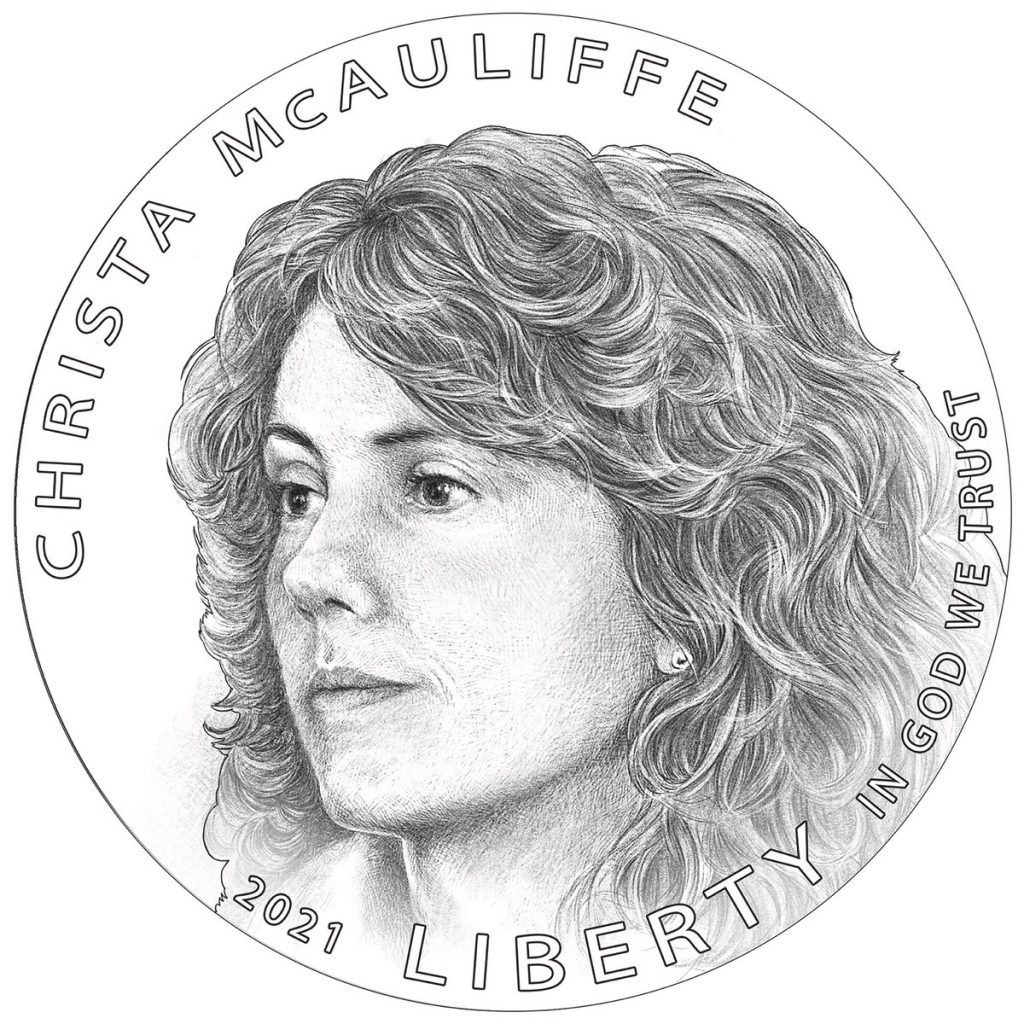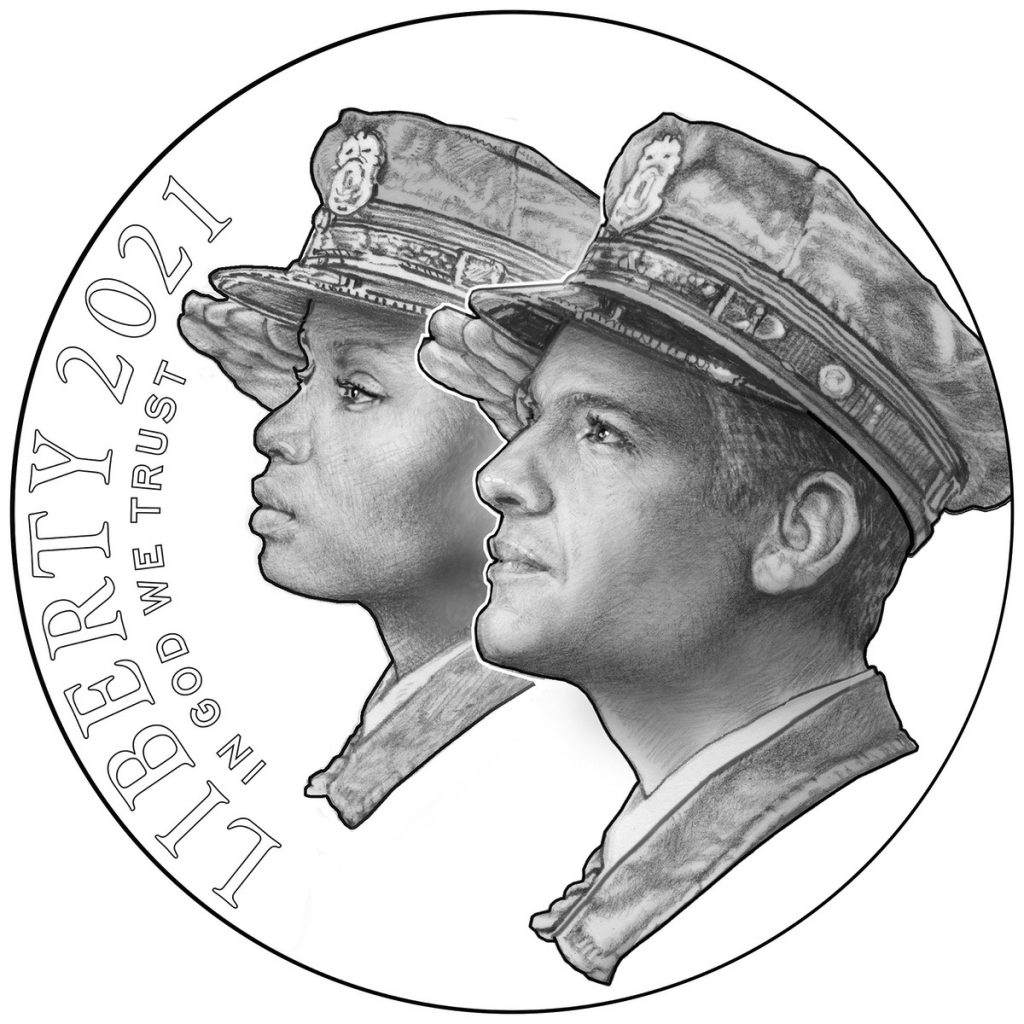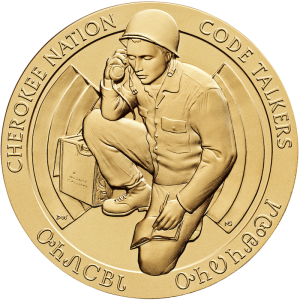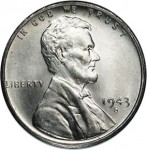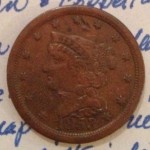HAPPY NEW YEAR 2021!
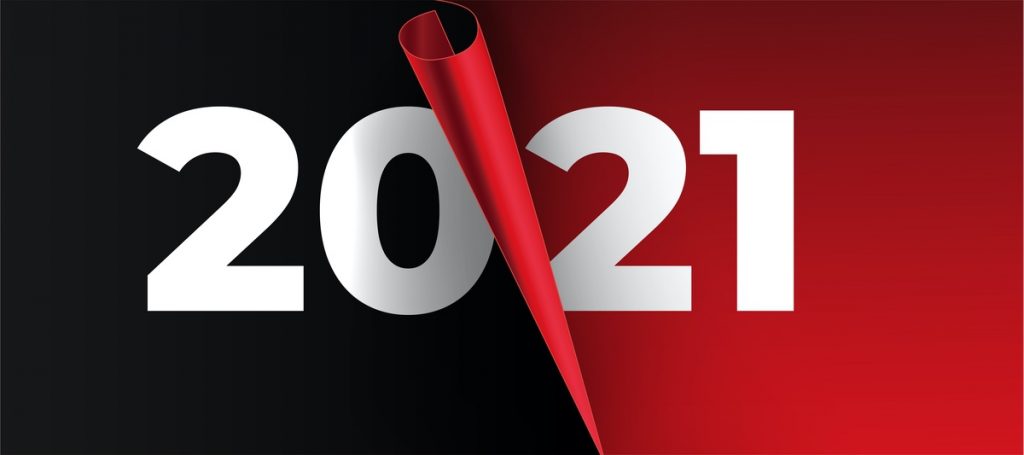
- 2021 Christa McAuliffe Silver Dollar (U.S. Mint line art)
- 2021 National Law Enforcement Memorial and Museum Commemorative $5 Gold Coin (U.S. Mint line art)
Memorial Day of 2014
The next year, southern states began their own Memorial Days to honor their soldiers who died during the war. No specific date was used but occurred in late April through June. By 1880, there was a more organized Confederate Memorial Day. These celebrations honored specific soldiers to commemorate the Confederate “Lost Cause.” By 1913, a sense of nationalism saw a commemoration of all soldiers that have died in battle.
In the north, the fraternal organization of Civil War veterans The Grand Army of the Republic began organizing “Decoration Day” in 1868. Decoration Day was to honor the fallen by decorating the graves of Union soldiers with flowers and flags. Ceremonies included speeches that were a mix of religion, nationalism, and a rehash of history in vitriolic terms against the Southern soldiers. The acrimony against the South began to subside by the end of the 1870s.
Memorial Day did not take on national significances until after World War I. Rather than being a holiday to remember those of died in service during the Civil War, the nation began to recognize all those who gave the ultimate sacrifice during all conflicts. By the end of World War II, most of the celebrations were renamed from Decoration Day to Memorial Day. Memorial Day did not become an official holiday until 1967 and its date changed from the traditional May 30 to the last Monday of the month by the Uniform Holidays Act (Public Law 90-363, 5 U.S.C. § 6103(a)) in 1968.
Regardless of how you view the current world conflicts, the men and women who serve in our military deserve the honor and respect for their service. Pray for their ability to safely return home.
We will resume numismatic writings shortly.
No, it wasn’t a double-strike
Too many serious topics lately. Let’s have a little numismatic fun.
 It was a busy day. While I really wanted to go out for lunch, all I had time for was to go to the cafeteria in the building where I work to get something quick. After settling on something I went to pay handing the cashier a piece of paper with the portrait of Andrew Jackson. In the change returned were three quarters. Most of the time I will just drop the change in my pocket and check it out later. But on this day, I took a glance at the coins and something struck me. Well, it didn’t strike me but it looks like something struck one of my quarter. Twice!
It was a busy day. While I really wanted to go out for lunch, all I had time for was to go to the cafeteria in the building where I work to get something quick. After settling on something I went to pay handing the cashier a piece of paper with the portrait of Andrew Jackson. In the change returned were three quarters. Most of the time I will just drop the change in my pocket and check it out later. But on this day, I took a glance at the coins and something struck me. Well, it didn’t strike me but it looks like something struck one of my quarter. Twice!
Closing my hands around the coins I walked away from the cash register and found a place I could stop to better examine what I had. Did I just find a rare double-strike quarter? Is it really an error? How much could it be worth?
Putting down my lunch container, I opened my hand and found quarters. Not just one but three quarters. Three 2013 Mount Rushmore quarters. It was not a double-strike but the double-image of the side-by-side portraits that fooled me.
And this happened more than once. If I take a quick glance at change that contains the Mount Rushmore quarters I get the impression that I found a double-struck coin.
The Mount Rushmore quarter has to be one of the better designs of the America the Beautiful Quarters® Program. Rather than attempting to be a pretty postcard-like image of the place of honor, the design is more about the sculpting of the impressive monument.
So be careful when glancing at your change. Those two faces side-by-side is not a double-strike or double-die. It is just a portrait of a portrait of George and Thomas being immortalized in granite.
Ancient Collectors need your help
 Before I begin today’s missive, please read the story I wrote about my friends who were arrested at the airport of a foreign country after digging up the $20 worth of ancients coins they found on a beach while playing in the sand. Go ahead… (click here) I’ll wait!
Before I begin today’s missive, please read the story I wrote about my friends who were arrested at the airport of a foreign country after digging up the $20 worth of ancients coins they found on a beach while playing in the sand. Go ahead… (click here) I’ll wait!
It is difficult to ignore the law of unintended consequences of Cultural Property Implementation Act (CPIA; 19 U.S.C. §§ 2601 et seq.) and how it is implementation by the State Department’s Cultural Property Advisory Committee (CPAC). Unfortunately, they are at it again.
CPAC will hold meetings on June 2-4, 2014 to review a new cultural property request from the Government of the Arab Republic of Egypt seeking import restrictions on archaeological and ethnological material. As with all of the other Memos of Understand (MOU), it will include ancient coins, even those that are common for ancient collectors and will also contain fuzzy language to make it look like Egypt could try to seek the return of undocumented items no matter when they were purchased.
The Ancient Coin Collectors Guild (ACCG) needs your help to make sure that the MOU between the United States and the Arab Republic of Egypt does not turn ancient coin collecting into a hobby where collectors have to look over their shoulders to watch out for foreign agents looking to confiscate their collections. This is not conspiracy theory talk. It has actually happened. Read the account by Patrick Heller in this article printed in Numismatic News (see the paragraph beginning with “Number four….”).
I ask that you support the ACCG and its efforts to prevent the government overreach into coin collecting by asking the State Department to “Exempt Ancient Coins” in whatever words or with whatever reasons you wish to offer. All you have to do is go to http://www.regulations.gov/#!docketDetail;D=DOS-2014-0008 and click on the blue “Comment Now” button on the right side of the page.
Comments are due by WEDNESDAY, May 14, 2014 before midnight.
Your effort is important and will be very much appreciated by the ACCG and the entire collecting community.
You should comment to the U.S. Mint
Although the U.S. Mint does not define who they consider stakeholders but does mention the “coin industry” in one paragraph, the guideline questions are clearly targeted to the coin-operated machine industry. Coin-op machines are more than the soda and candy machines that may be in the break room where you work. These machines include toll booth machines, machines that produce bus and/or train fare cards, parking meters, game machines, and even the few pay telephones that are still in use. Everything that accepts coins will have to be replaced, repaired, adjusted, or scrapped should there be a change in coinage metals.
The trouble that the United States is in for can be seen just across the border in Canada. Although the Royal Canadian Mint produced test tokens that anyone could have used to verify and adjust their systems two years prior to the introduction of the new Loonie (C$1) and Toonie (C$2) coins, Canadian news followed the trials and tribulations of many communities whose parking meters and other parking-related systems would not accept the new coins.In the United Kingdom, the Bank of England and law enforcement is engaged in a difficult fight against counterfeit £1 coins. Sources estimate that between 3-percent of the £1 coins in circulation are fake amounting to more than 45 million counterfeit coins. These fakes are so convincing and very well constructed that they can be successfully used in vending machines for payment including in London’s Underground. In an attempt to stem the problem, the Royal Mint has designed a new £1 coin to be circulated by 2017 in hopes to cut the counterfeiting rate.
Changes in the Loonie and Toonie were subtle as compared to the changes in the £1 coin. While the size of the coin will remain about the same, it will go from being round to have 12 sides. Rather than it being make of one metal, the new coin will be bi-metallic with a yellow metal on the outer ring and a silver-colored inner core. Rather than the edge being milled with a single incuse inscription, the edge will have alternating milling and the year in Roman numerals on each of the sides.The coin-operated businesses in Britain are beginning to complain about the changes even though they are being given nearly three years to adjust. For their systems, the new coins will have a different weight, specific gravity, and the electromagnetic signature will differ from the current coin. Every system from the Underground to parking systems to food and beverage vending machines will have to be upgraded to accept the new coins. One report estimates that it will cost up to £50 million (approximately $82.3 million) just to update parking systems.
The Automatic Vending Association, the U.K.’s vending industry trade group, estimates that the new coin will costs its members over £100 million ($168.5 million) to convert their machines.
Expect the costs in the United States to be much higher mainly because of scale. The National Automatic Merchandising Association (NAMA), the $45 billion per year vending industry trade association in the United States, has already issued a report saying that it will cost from $100 to $500 per machine to convert them to accept new coinage.
The American Amusement Machine Association (AAMA) has come out against any change in U.S. coinage. It was reported that AAMA president John Schultz said to leave the coinage alone “because it works, rather than risk the costly consequences.” AAMA has not provided an estimate for those costly consequences.
The last significant change in coinage composition was in 2000 on the introduction of the Sacagawea “Golden” dollar coin. Following the debacle of the Susan B. Anthony small dollar coin that was mistaken for a quarter, the coin was redesigned without a reeded edge and given a golden color by adding manganese to the metals mix. Although this change primarily impacted the gaming industry that relied on the dollar coin, the vending machine industry did respond by converting old machines and manufacturing new ones that accepted the new coin.
Previously, the one cent coin went from being made of 95-percent copper and the rest zinc to being made of 98.5-percent zinc with a copper coating. Not only did this change occur in the middle of 1982, but it created seven collectible varieties of coins that are not that expensive to own. Although this change did not affect many industries, new automated cash registers being used primarily at grocery and home improvement stores can accept both the copper and zinc coins without problems.Any discussion of coin composition changes has to include the change from silver to clad coinage. When President Lyndon B. Johnson signed the Coinage Act of 1965 (Pub. L. 89-81) into law on July 23, 1965, the composition of the dime and quarter dollar was change from 90-percent silver and 10-copper to 75-percent copper and 25-percent nickel bonded to a core of pure copper. This mix of metals was selected so that the coins would have an electromagnetic signature that was very similar to their silver counterparts. The half-dollar was reduced to 40-percent silver surrounding a pure copper core.
This change in coinage was done for the same reason that congress has asked the U.S. Mint to study alternative metals: the cost of materials and labor to make the coins is higher than the face value of the coin. As of the Fiscal Year 2013 (October 2012-September 2013) Annual Report, it costs the U.S. Mint 1.83 cents in labor and materials to manufacture the one cent coin and 9.41 cents for the five cents coin.
As a comparison, the cost for the dime including labor and materials is 4.56 cents per coin while the quarter dollar costs 10.5 cents to make.
Deciding what to do about U.S. coinage goes beyond the accounting details. A change by the federal government will impact everyone domestically and those overseas that use the dollar as their currency. There will be quite a few collateral issues including economic, political, and philosophical considerations. From a policy perspective, congress will have to think about the following before making any changes to our change:- Does the U.S. eliminate the one cent coin?
- Does the U.S. eliminate the one dollar note in favor of a coin?
- If a transition to new metals is approved, does the government provide economic assistance to small businesses and sectors that will feel a bigger impact from this change?
- Will the federal government provide assistance to communities to help convert municipal services to be able to take the new coins?
- Should the U.S. Mint, a government agency, be allowed and/or required to earn a profit from its operations?
- How will the people be educated on the new coinage?
- What role will the Federal Reserve play?
Since the U.S. Mint did not define who their stakeholders are, it is fair to say that the stakeholders are all citizens of the United States. If you would like to comment, the U.S. Mint is looking for input on the following factors:
- Weight
- Electromagnetic signature
- Visual changes, such as color and relief
When commenting, note that the U.S. Mint said it is not considering aluminum alloy metals.
Responses are due to the U.S. Mint 60-days following its printing in the Federal Register (April 10, 2014 making the due date June 9, 2014). Electronic comments can be sent to Coin.StakeholdersResponse@usmint.treas.gov. If you prefer to send your comments the traditional way, mail them to Coin Stakeholders Response, Office of Coin Studies, United States Mint, 801 9th Street NW., Washington, DC 20220.
If you do comment and would like to share what you said with the rest of the community, either send it to me via email or post it as a comment below.
Summary of April coin-related legislation
Our long national nightmare is over, congress finally passed some sort of numismatic-related legislation. But do not get too excited because today’s news out of the House of Representatives is only the beginning. Next is for the Senate to do nothing while the bill languishes in committee.
